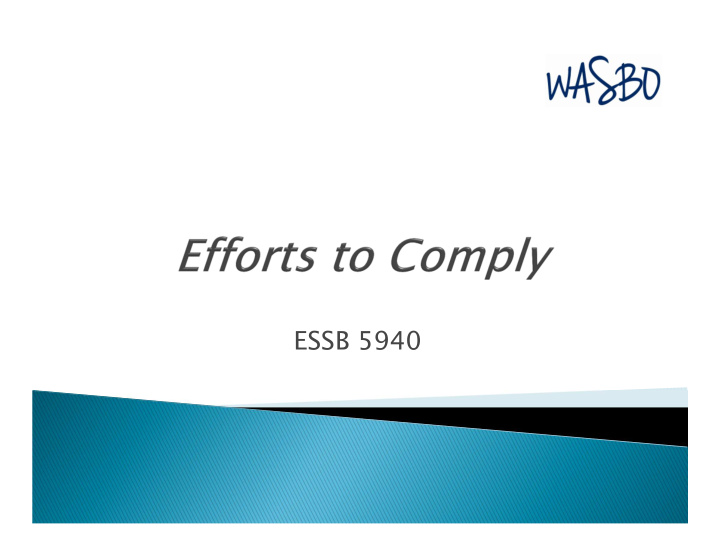



ESSB 5940
ESSB 5940 Good Bill Bad Bill
Improve Transparency Create greater affordability Promote health care innovations and cost savings Provide greater parity in state allocations for state employees and K-12 employees Retain collective bargaining
While there will likely be changes made to ESSB 5940 in the 2013 Legislative Session, the Intent shall remain.
Each employee who elects medical coverage must pay a “minimum premium charge” Employee premiums must be structured so that employees who elect richer benefit plans pay higher premium charge Must have a Qualified High Deductable Health Plan (QHDHP) and Health Savings Account (HSA)
Data must be reported annually to the Office of Insurance Commissioner including: Progress toward greater affordability full coverage and cost savings Compliance to offer QHDHP and HSA Total Premium Expenses Total Claim Expenses Claims Reserves Plan administrative expenses Use of innovative health plan features
Additional Data reporting requirements: Aggregated demographic information Total claim payments by benefit package Listing of large claims > $100,000 including primary diagnosis and enrollment status Report on progress towards goal to reduce health care costs
Data reporting specific to employee coverage: FTE status Type of Coverage or benefits received including dependent status District contributions to premium Employee payroll deductions Age and sex of employee and each dependent Summary of benefits packages Premium differentials between employee only and full family coverage
Required to provide data format requirements and reporting dates By December 1, 2013 (and then annually) provide a summary report to the legislature on data If a school district does not provide data, OIC is to inform OSPI who could require benefits to be purchased through PEBB If benefit provider (carrier or third party administrator) does not provide data, OIC can take enforcement action.
By June 1, 2015, HCA must report to the Governor and Legislature: Specific targets to realize goal of greater payroll deduction equity. Appropriateness of 3:1 ratio for full family coverage to employee only coverage Advantages and disadvantages of consolidated health benefits purchasing plan for K-12 Discuss whether a consolidated purchasing plan is better for certificated or classified employees.
By December 31, 2015, JLARC must review reports from OIC and HCA and report to Legislature on goals: ◦ Improve transparency ◦ Create greater affordability ◦ Promote health care innovations and cost savings ◦ Specific targets to realize goals ◦ Allocate $5 million in performance grants to high performing districts to reduce copays and deductibles.
Minimum deductible of $1,200 for single coverage Minimum deductible of $2,400 for family coverage Maximum annual out-of-pocket of $6,050 for single coverage Maximum annual out-of-pocket of $12,100 for family coverage
Must be in combination with HDHP Belongs to the account holder (employee) Is portable (stays with employee) Deposits are pre-tax HSA earnings are tax free Withdrawals are tax free as long as they are used for eligible health care expenses.
$700.00 $600.00 HSA $500.00 $400.00 Premium Paid Premium Paid $300.00 $200.00 $100.00 $- Traditional Plan HDHP & HSA
Plan Design 2010 Pre-existing condition limits for children prohibited Lifetime dollar limits prohibited Annual dollar limits restricted Must cover adult children to age 26 Must cover preventive care without cost sharing
W-2 Reporting 2012 Most employers are required to report the aggregate cost of specified employer-sponsored health coverage on employee W-2 forms beginning with the 2012 calendar year.
All employees who work at least 30 hours per week, and their dependents, need to be eligible for at least one health care coverage option. (Free Rider Penalty) A 40% non-deductible excise tax may be imposed on insurers if the aggregate value of employer- sponsored health coverage exceeds threshold amounts. (Cadillac Tax)
Honor the Intent / Legislative Goals Continue to find answers Develop a timeline QHDHP / HSA available for 2012-13 school year Training for Payroll/Benefits Personnel Documenting our efforts toward “progress” Require Providers to secure and share data Understanding Bargaining Issues
Recommend
More recommend